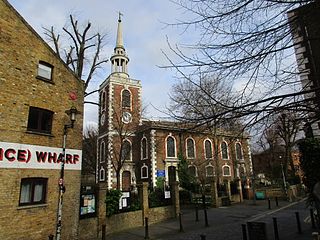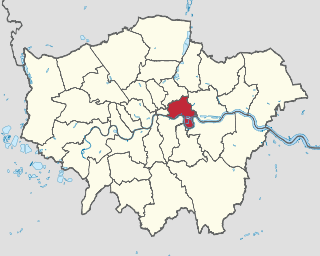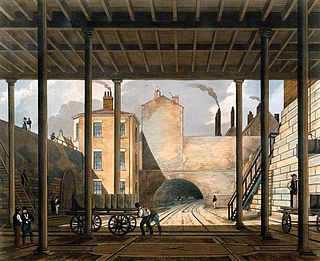See also
- Battle of Wapping Heights, a battle in Warren County, Virginia, during the American Civil War
- Wappinger, a Native American people from what is now southern New York and western Connecticut
Wapping is an area in East London, England.
There are various articles associated with Wapping, London:

Bermondsey is a district in southeast London, part of the London Borough of Southwark, England, 2.5 miles (4.0 km) southeast of Charing Cross. To the west of Bermondsey lies Southwark, to the east Rotherhithe and Deptford, to the south Walworth and Peckham, and to the north is Wapping across the River Thames. It lies within the historic county boundaries of Surrey.

Rotherhithe is a district of south-east London, England, and part of the London Borough of Southwark. It is on a peninsula on the south bank of the Thames, facing Wapping, Shadwell and Limehouse on the north bank, as well as the Isle of Dogs to the east of the Thames and is a part of the Docklands area. It borders Bermondsey to the west and Deptford to the south east.

Wapping is a district in East London in the London Borough of Tower Hamlets. Wapping's position, on the north bank of the River Thames, has given it a strong maritime character, which it retains through its riverside public houses and steps, such as the Prospect of Whitby and Wapping Stairs. It also has a Royal Navy shore establishment base on the riverfront called HMS President and home to Tobacco Dock and King Edward Memorial Park.

The London Borough of Tower Hamlets is a London borough covering much of the traditional East End. It was formed in 1965 from the merger of the former metropolitan boroughs of Stepney, Poplar, and Bethnal Green. 'Tower Hamlets' was originally an alternative name for the historic Tower Division; the area of south-east Middlesex, focused on the area of the modern borough, which owed military service to the Tower of London.

Canary Wharf is an area of London, England, located near the Isle of Dogs in the London Borough of Tower Hamlets. Canary Wharf is defined by the Greater London Authority as being part of London's central business district, alongside Central London. With the City of London, it constitutes one of the main financial centres in the United Kingdom and the world, containing many high-rise buildings including the third-tallest in the UK, One Canada Square, which opened on 26 August 1991.

Edge Hill is a district of Liverpool, England, south east of the city centre, bordered by Kensington, Wavertree and Toxteth.

Blackwall is an area of Poplar, in the London Borough of Tower Hamlets, East London. The neighbourhood includes Leamouth and the Coldharbour conservation area.

The London Docks were one of several sets of docks in the historic Port of London.

Bristol Harbour is the harbour in the city of Bristol, England. The harbour covers an area of 70 acres. It is the former natural tidal river Avon through the city but was made into its current form in 1809 when the tide was prevented from going out permanently. A tidal by-pass was dug for 2 miles through the fields of Bedminster for the river, known as the "River Avon New Cut", "New Cut", or simply "The Cut". It is often called the Floating Harbour as the water level remains constant and it is not affected by the state of the tide on the river in the Avon Gorge, The New Cut or the natural river southeast of Temple Meads to its source.

Crown Street Station was a passenger railway terminal station on Crown Street, Liverpool, England. The station was the world's first intercity passenger station, opening in 1830, also being the railway terminal station for Liverpool. Used for passengers for only six years, the station was demolished as the site was converted into a goods yard. The goods yard remained in use until 1972. The location of the station is now a park with little trace of the station or goods yard.

Wapping or Edge Hill Tunnel in Liverpool, England, is a tunnel route from the Edge Hill junction in the east of the city to the Liverpool south end docks formerly used by trains on the Liverpool-Manchester line railway. The tunnel alignment is roughly east to west. The tunnel was designed by George Stephenson with construction between 1826 and 1829 to enable goods services to operate between Liverpool docks and all locations up to Manchester, as part of the Liverpool and Manchester Railway. It was the first transport tunnel in the world to be bored under a city. The tunnel is 2,030 metres (1.26 mi) long, running downhill from the western end of the 262 metres (860 ft) long Cavendish cutting at Edge Hill in the east of the city, to Park Lane Goods Station near Wapping Dock in the west. The Edge Hill portal is near the former Crown Street Station goods yard. The tunnel passes beneath the Merseyrail Northern Line tunnel approximately a quarter of a mile south of Liverpool Central underground station.

Edge Hill railway station is a railway station that serves the district of Edge Hill, Liverpool, England and is one of the oldest railway stations in the world

The Port of Liverpool is the enclosed 7.5-mile (12.1 km) dock system that runs from Brunswick Dock in Liverpool to Seaforth Dock, Seaforth, on the east side of the River Mersey and the Birkenhead Docks between Birkenhead and Wallasey on the west side of the river. The port was extended in 2016 by the building of an in-river container terminal at Seaforth Dock, named Liverpool2. The terminal can berth two 14,000 container Post-Panamax ships.

Salthouse Dock is a dock on the River Mersey, England, and part of the Port of Liverpool. It is situated in the southern dock system, connected to Canning Dock to the north, Wapping Dock via Wapping Basin to the south and Albert Dock to the west.

The Bristol Harbour Railway was a standard-gauge industrial railway that served the wharves and docks of Bristol, England. The line, which had a network of approximately 5 mi (8.0 km) of track, connected the Floating Harbour to the GWR mainline at Bristol Temple Meads. Freight could be transported directly by waggons to Paddington Station in London. The railway officially closed in 1964.

Park Lane was the world's first goods terminus on the Liverpool and Manchester Railway serving the south end Liverpool Docks. The station was opened in 1830. Its initial name was Wapping Station. The goods station was accessed from Edge Hill rail junction in the east of the city via the 1.26 miles (2.03 km) long Wapping Tunnel.

The Victoria Tunnel in Liverpool, England is a 1.537 miles (2.474 km) long rail tunnel. Opened in 1849, its eastern portal is adjacent to Edge Hill station. The western portal opens into a short cutting, between Byrom Street and Fontenoy Street, the shorter Waterloo Tunnel exits the cutting terminating at Waterloo Dock. The Victoria and Waterloo tunnels are effectively one long tunnel connected by a ventilation cutting. The whole length is generally known as the Waterloo Tunnel.
Liverpool in North West England, is a major British city with significant road, rail, and ferry networks, in addition to an international airport and a well-known dock system. As with most other major UK cities, Liverpool's transport infrastructure is centred on its road and rail networks. Public transport services within the city are controlled and run by Merseytravel.

Liverpool city centre is the commercial, cultural, financial and historical centre of Liverpool, England.